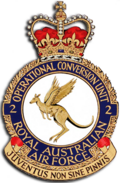No. 2 Operational Conversion Unit RAAF
| No. 2 Operational Conversion Unit RAAF | |
|---|---|

No. 2 OCU's crest
|
|
| Active | 1942–47 1952–current |
| Country | Australia |
| Branch | Royal Australian Air Force |
| Role | Operational conversion Refresher courses Fighter combat instruction |
| Part of | No. 81 Wing |
| Garrison/HQ | RAAF Base Williamtown |
| Motto(s) |
Juventus Non Sine Pinnis ("The Young Shall Have Wings") |
| Commanders | |
| Notable commanders |
Peter Jeffrey (1942–43, 1944–46) Wilfred Arthur (1944) Dick Cresswell (1953–56) Neville McNamara (1959–61) |
| Aircraft flown | |
| Fighter | F/A-18 Hornet |
No. 2 Operational Conversion Unit (No. 2 OCU) is a fighter training unit of the Royal Australian Air Force (RAAF). Located at RAAF Base Williamtown, New South Wales, the unit trains pilots to operate the McDonnell Douglas F/A-18 Hornet, conducts refresher courses for pilots returning to the type, and trains future Hornet instructors. Pilots new to the Hornet enter No. 2 OCU after first qualifying to fly fast jets at No. 79 Squadron and undertaking initial fighter combat instruction at No. 76 Squadron. Once qualified on the F/A-18, they are posted to one of No. 81 Wing's operational Hornet units, No. 3 Squadron, No. 75 Squadron or No. 77 Squadron.
The unit was established as No. 2 (Fighter) Operational Training Unit (No. 2 OTU) in April 1942 at Port Pirie, South Australia, and relocated to RAAF Station Mildura, Victoria, the following month. During World War II, it provided training on a wide range of aircraft, including P-40 Kittyhawks, Vultee Vengeances, Avro Ansons, CAC Boomerangs, Supermarine Spitfires and Airspeed Oxfords. Disbanded in March 1947, No. 2 OTU was re-formed at Williamtown in March 1952 in response to the demand for more highly trained pilots to serve in the Korean War. It was renamed No. 2 (Fighter) Operational Conversion Unit in September 1958, and since then has conducted training with the CAC Sabre, Dassault Mirage III, and Macchi MB-326, prior to taking delivery of the Hornet.
...
Wikipedia
